
The Road Ends Here: What Ambler Project’s Effects Would Be On Brooks Range Habitat
The following appears in the December issue of Alaska Sporting Journal:
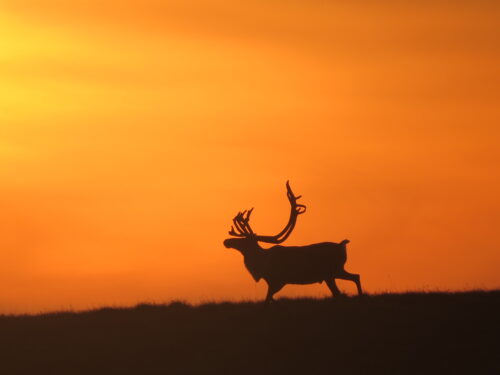
BY BJORN DIHLE
I was on my hands and knees on a mountainside in the Brooks Range searching for the last of the season’s shriveled, half-frozen blueberries. It was early September; winter was not far away. I was seven weeks into a two-part traverse of the mountain range and had timed my food supply to last to a rendezvous point where two friends were supposed to fly in with more, as well as inflatable boats.
Then, we’d float the 400 miles to the Chukchi Sea. However, they’d failed to show up on our agreed-upon date. I knew it was probably a weather hold, but with no food I was growing rapidly weaker each passing day. A rushing sound startled me and I rolled over, yanking my pistol out. I figured it was a grizzly. Instead, six bull caribou charged past just yards away. Something had been chasing them.
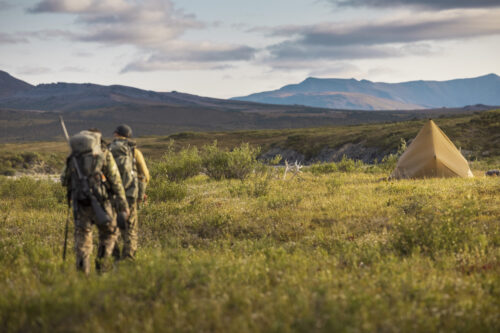
I cocked my pistol, aimed at the smallest one and thought about ending my hunger. As I watched the caribou disappear into the tundra, I wondered if I’d made the wrong decision not pulling the trigger. I didn’t want to waste meat or attract bears, but maybe something had happened and my friends weren’t coming. Suddenly, a howl rose up from the valley below. Other wolves joined in. I spent the next few hours limping through the willows, hoping to find a fresh caribou kill, until I gave up and sat on a tussock with my head in my hands. A nearby howl roused me. A white wolf appeared on a knoll, a sentinel, eying me suspiciously as the rest of its pack feasted on a caribou back in the willows.
THE BROOKS RANGE IS Alaska’s Arctic-most mountain range, and it stretches roughly 700 miles across the top of the state. It is many things to different people, but outdoorsmen and -women know it as America’s most wild and remote hunting and fishing grounds.
I’m a lifelong Alaskan hunter who, even before my parents set me free in the woods with a .22 rifle, lived vicariously through my dad’s annual hunts. I’ve hunted caribou in the Arctic numerous times. It was the same year, 2009, that I made the two-part, nine-week traverse of the Brooks Range that the Ambler Road project became public knowledge.
Not long after that trek, I sat in on a legislative listening session in Juneau to learn more. Being surrounded by politicians was a bizarre juxtaposition to the thousands of caribou, dozens of grizzlies, Dall sheep, wolves and wolverine I’d recently experienced in the field. But it was there that I learned the Ambler Road project would be a 211-mile-long industrial road with an up-to-400-foot right-of-way across the Brooks Range to help foreign-owned companies develop at least four – and probably more – open-pit copper, lead, zinc and gold mines.
The road would act as a gateway for more industrial development to sprawl through the Brooks Range. It would also cost approximately $2 billion, financed by the publicly funded Alaska Industrial Development and Export Authority, or AIDEA, a state-owned corporation. In theory, the cost would be paid back through tolls paid by mining companies. In reality, that is a big and questionable act of faith. The preferred route would cross 11 rivers and around 2,900 streams, degrading fish and wildlife habitat, and be closed to the public.
The memory that stands out about that legislative listening session was a state representative berating a woman after she raised concerns that the megaproject would negatively affect the Western Arctic Caribou Herd.
“All I ever hear is about caribou! People need jobs! They need something to wake up in the morning for!” he yelled.
I’ve followed the Ambler Project ever since that meeting. Altogether, I’ve probably spent six months hunting and wandering the Brooks Range, and it’s offered me perspective on what’s at stake. I’ve also had conversations with people in the mining industry who have called the megaproject a good economic opportunity for the region’s population. A lot of the minerals could be used for green energy. Yet one geologist confided that he hoped the project would never be built because he had experienced the Brooks Range and he thought it was more valuable to leave the place as it was.
And I’ve chatted with people who live in the Brooks Range and who’ve said if the Ambler Road Project were to happen, it would be the “death of deep wilderness and the end of a lifestyle.”

I’VE TALKED WITH HUNTERS who are fully aware that a trip to Alaska’s Brooks Range is the trip of a lifetime. With no public access and the road’s potentially devastating impacts to fish and game, the megaproject is a lose-lose situation for all of us who live by the rifle and rod. That’s a large reason why opposition against the proposal is rapidly growing among hunters and anglers.
The Theodore Roosevelt Conservation Partnership’s mission is pretty simple: “To guarantee all Americans have quality places to hunt and fish.” The Ambler Road endangers one of the nation’s greatest places to do that. That’s why TRCP has helped organize Hunters & Anglers for the Brooks Range (huntfishbrooksrange. com), which “is a collective of seasoned hunters, anglers, conservationists and leading outdoor brands.” All “are committed to defending the wild and remote character of Alaska’s Brooks Range – a world-class hunting and fishing destination – from the proposed Ambler Industrial Road.”
Jen Leahy, the Alaska program manager for TRCP, is clear why the Ambler Road is a bad idea.
“The risks of this proposal far outweigh the benefits. Hunters and anglers understand the Brooks Range is most valuable exactly how it is: vast, wild, and remote. This is the kind of place you take your dad for his last big hunt,” she said. “It’s where you bring your kids for a wilderness float trip they’ll always remember. Even in Alaska, this degree of solitude is rare. We’re not willing to trade the enduring legacy of the Brooks Range for wildly optimistic promises by foreign-owned mining companies.”
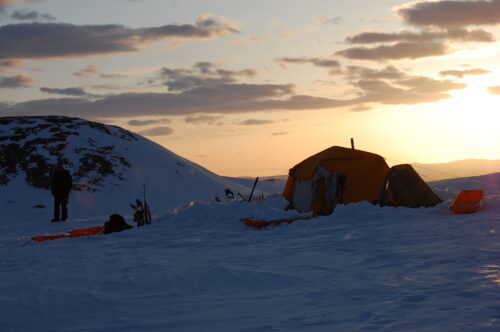
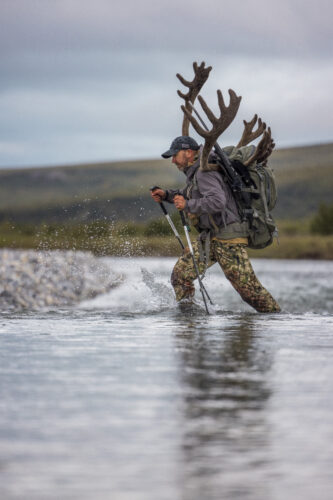
IT’S NOT JUST PEOPLE looking to experience a trip of a lifetime to the wildest country left in North America who are opposing the megaproject. Dozens of Alaska Native Tribes are collectively represented by multiple standing resolutions opposing the Ambler Road. Their main reason is that the road, if built, would negatively impact traditional ways of life, to which hunting and fishing is essential.
The Native corporation Doyon, the largest private landholder in Alaska, recently canceled a land access agreement with AIDEA, citing “poor treatment.” They have no plan to enter a new land access agreement with AIDEA for the 10 to 12 miles of Doyon’s land the road would cross. This announcement creates a serious hitch in turning the Ambler Road into a reality.
Nonetheless, AIDEA announced it intends to spend $7 million in 2024 on the Ambler Road Project. That will mean AIDEA has spent $54 million on its efforts on the megaproject so far. Where and how that money has and will be used is unclear. An independent audit in 2022 exposed AIDEA as a “floundering entity” that has lost Alaska $10 billion since its formation 41 years ago. AIDEA board member Albert Fogle was quoted in an Anchorage Daily News report that the Ambler Road project is “near and dear to my heart,” and that the corporation should “really push the envelope on getting those developments. If that means going above and beyond, we need to do it. I mean, take some dozers and drills and make it happen.”
There is a good reason why AIDEA clings to the dream of making the proposed Ambler Road a reality. If built, it would very likely lead to an industrial sprawl of roads, and multitudes of mine and oil developments from the Dalton Highway to the Chukchi Sea. It would result in significant adverse impacts to wildlife, wild lands and the people who care about those things. To some people, that cost pales in comparison to the money that might be made.
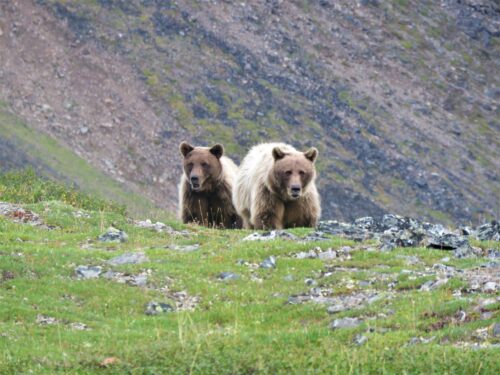
WHILE ATTENDING THE UNIVERSITY of Alaska in the early 2000s, I’d drive once or twice a year up the Dalton Highway into the Brooks Range to hunt caribou. Back then the Western Arctic Caribou Herd population was estimated at 490,000. Today, it’s down to 152,000.
Some locals have difficulty getting the meat they need. Under very controversial orders, significant portions of federal lands in Game Management Units 23 and 26a were closed to nonlocal caribou and moose hunters for the 2022 and 2023 seasons. It is unclear what will happen for the 2024 season, but it is clear that the Ambler Road would likely disrupt caribou migrations, which could ultimately result in even fewer hunting opportunities for all user groups.
My hunts and wanders up in the Brooks Range have been some of my favorite moments. The second part of my nine-week traverse was three weeks alone, paralleling the route the Ambler Road would take. I lost track of how many thousands of caribou I walked with – at least 20,000. I saw somewhere between 50 and 60 grizzlies.
One night I awoke, gun in hand, and ripped open the vestibule as a bear trampled the lower part of my tent. I came upon wolves at a den. I got stalked for hours by a sick, injured wolf. During those 60 or so days in the field, I encountered only three other people.
I’ve hunted and wandered much of Alaska, and the Brooks Range is the wildest, most epic country I’ve experienced. For me, and other hunters and anglers, that is definitely something worth waking up in the morning for.
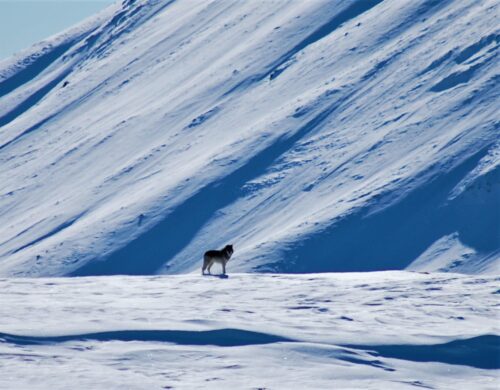
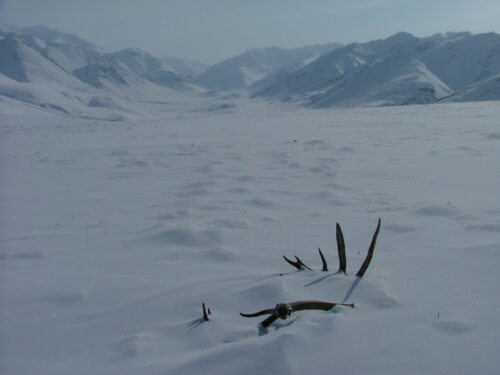
THE BUREAU OF LAND Management recently released a draft supplemental environmental impact statement for the proposed Ambler Road Project. The statement makes it clear that if built, the megaproject would negatively affect local and visiting hunters and anglers. The public has until December 22, 2023 to comment on the project’s EIS and take a stand safeguarding the future of America’s hunting and angling opportunities. ASJ
Editor’s notes: To comment on the project, go to https://eplanning.blm.gov/eplanning- ui/project/57323/510. You can also submit a comment at the following site: huntfishbrooksrange.com/. Author Bjorn Dihle is a lifelong Alaskan and hunter. This article was sponsored by the Theodore Roosevelt Conservation Partnership (trcp.org). Its mission is to guarantee all Americans quality places to hunt and fish.
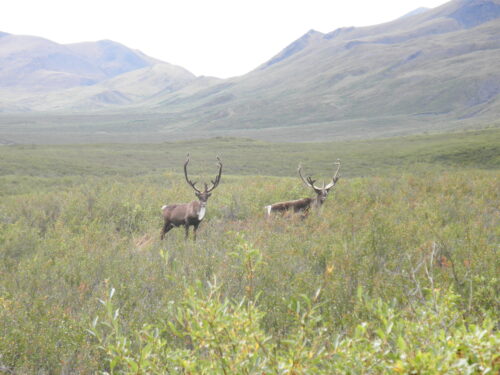
Sidebar: WHAT HAPPENED TO ALL THE CARIBOU?
As Alaska’s famed Western Arctic Caribou Herd, which Ambler Road critics say could be affected if the project is permitted, continues to decline, an unanswered question is this: What is the reason some caribou populations are declining?
Alaska Department of Fish and Game surveys have painted a dismal picture for the Western Arctic herd, which dropped sharply from 479,000 animals in the early 1990s through the mid-2010s, saw a modest increase around 2017, and then another decrease to only 152,000 bulls, cows and calves counted in 2023 surveys.
A bit of good news? The drop between 2022 and 2023 was less than the previous year, but it’s also still the fewest caribou that have been in the herd since the early 1980s.
When National Geographic magazine sent writer Neil Shea to Alaska and Canada’s Northwest Territories to figure out reasons behind the widespread decline of caribou, answers were as elusive as the animals themselves.
“I didn’t think there was a terrestrial large mammal left in North America that we didn’t know much about,” U.S. Geological Survey wildlife biologist Heather Johnson told Shea. “I thought, how can we possibly know so little about these animals? But then an older colleague said, ‘Heather, you’ve got to flip that around: You should be impressed that we know even as much as we do.’”
But whether it’s climate change, over-hunting, predation, mining or energy extraction, there doesn’t appear to be a definitive talking point to build on.
“I think by now if there was just one thing, we’d know it,” Canadian biologist Jan Adamczewski said in the December 2023 issue story. “But when you draw up a list of all the things that might be affecting caribou, it can be a very long list. And when you draw up a list of things you can do about it, it’s usually a very short list.”
Still, the report points out that industrial development like the proposed Ambler Road project would bring probably wouldn’t help herds like the Western Arctic either and is something to be concerned about in terms of the species’ long-term outlook.
“If there’s one thing they don’t like, it’s industrial development,” Johnson told NatGeo. “They are just really sensitive to development. It’s been shown so many times.” -Chris Cocoles



